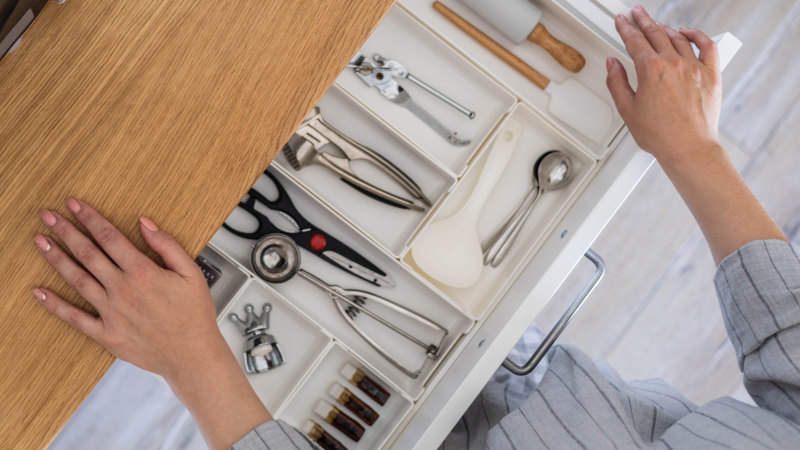[ad_1]

The cabinets: Focus on what you use and how you use it
The prime real estate in your cabinets – easy-to-reach shelves, drawers close to the dishwasher – should be devoted to whichever plates, dishes and cookware you use most often. “It’s about proximity, putting silverware in the drawer right next to the dishwasher, or coffee mugs right above the coffee-maker,” says White.
Drawers will stay neater if you use compartmentalised dividers like silverware trays and low-profile knife blocks. This also keeps items from sliding around in drawers and becoming jumbled. If your cupboards don’t have slide-out shelves (a feature in many newer kitchens), you can add your own.
For dishes and glassware you only need a few times a year – Grandma’s formal china, large serving platters – Roewer suggests “looking beyond the kitchen for storage”. He keeps his wine goblets and collection of cocktail swizzle sticks in his dining room sideboard and recommends that space-challenged clients place holiday-only plates and cups in padded, zippered containers that they stash in a closet or attic.
The fridge: Treat it like a closet
Pretend your refrigerator is a closet for food, and it may be easier for you to organise it. This means that like goes with like once again. “Subdivide the fridge with one spot for drinks, another for meat and cheese, another for produce,” says Mooney. You can do that using the drawers the appliance came with (veggie crisper, fruit drawer) or via a few see-through plastic bins on the shelves.
Loading
Roewer swears by a “file not pile” storage mantra, particularly in the freezer. “You want to put stuff into the drawer on its side so you can see more of it,” he says. “You can also take things like frozen pizzas out of their excess packaging before you put them away. That can save room.”
Regularly check the expiration dates of refrigerated items, and watch for rotting veggies or spoiled meat. Some newer smart fridges use AI to monitor food’s freshness, but you’ll still need to enter in when you bought that lettuce or the “best by” date on that yoghurt.
The counter tops: Corral visual clutter
From instant pots to knife blocks, anything you leave on kitchen counter tops can add to visual clutter. “Whatever you can do to cut down on the amount of stuff on the counter helps the room feel neater,” says Roewer. “Everyone has a different tolerance level, but in general, the less you have on the counter, the easier it is to keep clean.”
Magazine-worthy minimalism might not be possible in real life. But you can limit the load on your counters by clearing out a cabinet for storing small appliances, replacing a counter-top microwave with a drawer model, or buying a dish-drying rack that folds or rolls up so it can be stored out of sight when it’s not in use.
Corral the items you do leave on the counter in containers or “stations”. Place wooden spoons and spatulas in an oversize jar by the stove or create a beverage station with mugs, tea bags and a sugar canister on a tray next to the coffee machine.
Under the sink or above the stove: Maximise tight spots
When kitchen space is at a premium, awkward spaces can morph into storage spots. “Even though there are plumbing pipes under the sink, you could still add rollout drawers or install shelving for other supplies,” says Shannon Kadwell, a kitchen and bath designer. Or place a small tension rod across the length of the under-sink cabinet, just in front of the pipes, and hang bottles of cleaning supplies from it, nozzles first.
While the tiny cabinets above some range hoods usually get too hot for food storage, they can work for water bottles. Stack them horizontally on their sides, with or without a small rack to hold them in place. “And if you have space above your cabinets, put that to use,” says Roewer. “But anything placed in a high spot like that can get greasy or dusty, so put things you don’t use often – holiday cookie cutters, party supplies – in bins with lids.”
Washington Post
Make the most of your health, relationships, fitness and nutrition with our Live Well newsletter. Get it in your inbox every Monday.
[ad_2]
Source link